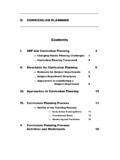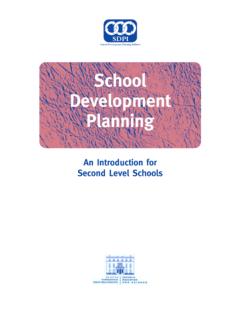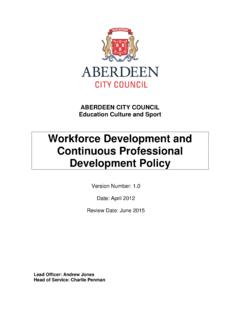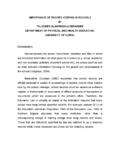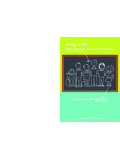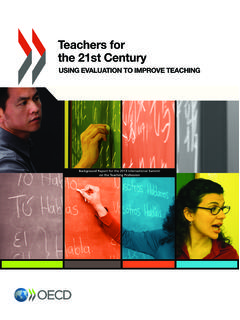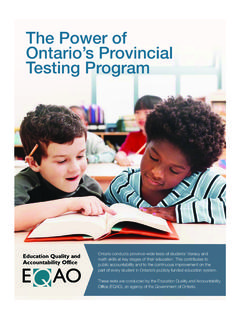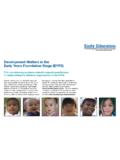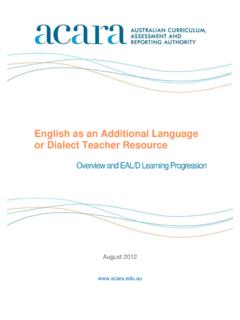Transcription of A Guide to Subject Inspection - SDPI
1 A Guide toSubject Inspectionat Second LevelCONTENTSSECTION 1 Code of Practice for Subject 2 Advance planning and 3 Procedures for the Inspection 4 Classroom 5 Recording Evidence during a Subject 6 The Subject Inspection Report (SIR)..24 THE INSPECTORATEE valuation Support and Research UnitOctober 2004 Design/print > Q design/print@4908 2011 CODE OF PRACTICE FOR Subject Inspection section 1A Guide TO Subject Inspection AT SECOND LEVELSECTION 1 CODE OF PRACTICE FOR Subject Inspection IntroductionThe evaluative function of the Inspectorate is defined by the provisionsof Section 13 of the Education Act, aims of evaluation are: To identify, acknowledge and affirm good practice in schools. To promote continuing improvement in the quality of educationoffered by schools. To promote self-evaluation and continuous development byschools and staff.
2 To provide an assurance of quality in the educational system as awhole, based on the collection of objective, dependable, highquality structured evaluation system, guided by the need for fairness, validityand consistency, both in the manner in which Inspection is carried out andin the style of reporting which it generates, is essential to the realisationof these aims. This Guide sets out the procedures which apply to Subject inspections insecond-level schools. It recognises that evaluations should not beprescriptive as to methodologies and acknowledges the need for diverseteaching approaches in accordance with the needs of students. It isintended to be a source of information to management and staff. Theseprocedures may vary, depending on the school and Subject context.
3 TheProfessional Code of Practice on Evaluation and Reporting for theInspectorategoverns the conduct of all forms of Inspection of underlying principlesIn its dealings with the school the Inspectorate will: Foster mutual respect and trust in the development of a positiveprofessional relationship with the school community. Foster partnership and collaboration. Demonstrate sensitivity towards the school in general. Recognise the ethos of the school. Engage in dialogue with school staff. Ensure confidentiality having regard to existing OF PRACTICE FOR Subject Inspection section 1A Guide TO Subject Inspection AT SECOND LEVELIn their professional relationships with teachers inspectors will: Demonstrate courtesy, respect and fairness. Make every effort to preserve the positive relationships betweenteachers and students.
4 Be sensitive towards individual teachers and the school in general. Ensure evaluative statements are carefully weighed against its evaluative functions the Inspectorate will: Be consistent in the application of evaluation criteria to ensureobjectivity and reliability leading to valid judgements and clearcommunication of outcomes. Ensure accuracy and reliance on first-hand evidence based onobservation. Be consistent and fair having regard to school context factors. Observe teaching and learning. Require the teacher to be present during visits to classrooms. Examine students school work, homework and journals, whereappropriate. Include interaction between inspector and students as part of theevaluative process, where appropriate. Place the students at the centre of learning and teaching.
5 Take cognisance of school self-review and other school-basedquality assurance procedures, where appropriate. Invite a teacher always to be present when students areinterviewed. Exercise due sensitivity when communicating with teachers in thepresence of students. Use different sources of information/evidence to corroboratefindings. This cumulative view of the different aspects of a subjectdrawn from a variety of perspectives and contexts will facilitate thetriangulation of data and improve the reliability of the Procedure for Review of Inspections on Schools and Teachers underSection 13(9) of the Education Act 1998 outlines the appeals procedurefor planning AND PREPARATION section 2A Guide TO Subject Inspection AT SECOND LEVELSECTION 2 ADVANCE planning AND PREPARATIONPre- Inspection data collection and reviewIn preparing for a Subject Inspection , the inspectors will obtain, fromDepartment of Education and Science and other sources, relevant schooland Subject data to include: Name of principal.
6 Student population. Names, qualifications, teaching hours etc. of teachers in subjectarea. Timetables daily timetables for Subject teachers, general schooltimetable indicating dates of holiday breaks. The time and class group allocation in the Subject per teacher. Number of classes and students taking the Subject . Programmes provided. Examination results. Some verification / updating of this data may be required of the school inthe context of the particular Inspection . Additional Subject -specific information, not provided by the Departmentdata, may be requested from the school during the initial phone call to theprincipal and / or by using a relevant Information Request Form (seesample on page 7).Inspectors will review school and student / teacher data in relation to thesubject, with a view to informing the Subject Inspection : Timetables will be reviewed with reference to the relevant sectionsof Rules and Programme for Secondary Schools/ Subject Syllabus/ Teacher Guidelines.
7 The curriculum organisation of the school will be reviewed, ifpossible, to ascertain the context of the Subject core / compulsory/ optional subjects, etc. Where a school s examination results in a particular Subject arereviewed, it will be with reference to the annual DepartmentStatistical Report in order to establish trends in uptake, levels atwhich examinations are taken and attainment in relation tonational norms. Inspectors will take school context factors into account inevaluating examination results. Areas that may require further investigation and / or clarificationduring the Inspection will be planning AND PREPARATION section 2 planning the Inspection day (or days)The Inspection day should include the following elements: An initial meeting with principalto confirm / discuss arrangementsand requirements.
8 An interview with principalor nominee regarding Subject provisionand whole school support for Subject . This element may followimmediately upon the initial meeting. Observation of arepresentative selection of lessons. A short preliminary meetingwith relevant Subject teachers,wherever possible. Substitute cover will be provided, if necessary. Observation of a representative selection of notmore than 2 lessons per teacher will be observed. However, wherethere is only one teacher, a third lesson should be observed inorder to provide a more accurate report on the learning andteaching of the Subject . In the case of practical subjects theselessons may be of double period duration. Feedback to individual teachersfollowing each lesson lesson observed should be followed, immediately if possible,by brief feedback to the teacher.
9 When circumstances do notfacilitate immediate feedback, the inspector will give feedback laterat a time convenient to both teacher and inspector. A review of students work and school / teacher documents andrecords. Feedback and discussionwith the Subject teachers as a group, if atall possible. Feedback to principal. Feedback may be given both to the subjectteacher group and to the principal collectively, if deemedappropriate by the inspector. This approach ensures transparencyand encourages a collaborative approach to improvement atsubject the Inspection dateIn general, a Subject Inspection will be carried out in one day. However, incertain cases, an additional day (or days) may be required, depending onthe size of school, the number of teachers of a Subject and the scope ofthe will decide on Inspection dates with reference to: Subject timetables so as to allow the essential aspects of thesubject at the required levels to be inspected.
10 This will alsodetermine the teachers / classes to be visited. The focus of the Guide TO Subject Inspection AT SECOND LEVEL5 ADVANCE planning AND PREPARATION section 2A Guide TO Subject Inspection AT SECOND LEVELP lease note that Subject inspections will not take place during the firsttwo weeks of the school year, the week preceding and the week followingthe Christmas holidays and the final week of the school classes to be inspected Factors which may be considered when selecting classes to be inspectedinclude: Focus of the Inspection ( Junior Cycle, Senior Cycle). Range of levels, years. Essential components of Subject . Range of teachers ( qualifications, experience, status ofteachers). Number of classes per Subject , in the interest of maintaining flexibility in planning theinspection, specific information regarding classes / teachers to be visitedwill not be communicated until the (first) day of the school of Inspection visitSchools will be given prior notice of a Subject Inspection .
